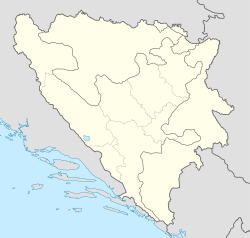Ugljevik
|
Ugljevik Угљевик |
||
|
|
||
| Basic data | ||
|---|---|---|
| State : | Bosnia and Herzegovina | |
| Entity : | Republika Srpska | |
| Coordinates : | 44 ° 42 ′ N , 19 ° 0 ′ E | |
| Height : | 158 m. i. J. | |
| Area : | 164 km² | |
| Residents : | 14,412 (2018) | |
| Population density : | 88 inhabitants per km² | |
| Telephone code : | +387 (0) 55 | |
| Postal code : | 76330 | |
| Structure and administration (as of 2016) | ||
| Mayor : | Vasilije Perić ( SDS ) | |
| Website : | ||
Ugljevik ( Serbian - Cyrillic Угљевик ) is a small town and seat of the municipality of the same name in northeast Bosnia and Herzegovina . It has belonged to the Republika Srpska since the Bosnian War .
geography
The place is located on the northeastern slope of the Majevica Mountains on the banks of the Janja at an altitude of about 160 m.
history
Ugljevik was first mentioned in Turkish records in 1533 . With the start of coal mining in 1899, numerous mining settlements emerged. In 1980 part of the old main town of Stari Ugljevik was demolished for the expansion of the opencast mine. In the period that followed, a new capital was built a few kilometers away as planned, which was initially called Novi Ugljevik . After the Bosnian War , part of the municipality was separated and today forms the municipality of Teočak, which belongs to the canton of Tuzla .
population
At the time of the 1991 census, the Ugljevik municipality had 25,587 inhabitants, of whom 14,468 (56.5%) were Serbs , 10,241 (40.0%) were Bosniaks , 290 (1.13%) were Yugoslavs and 56 (0.2 %) called Croatians .
In the actual city lived 2,981 inhabitants, of which 2,426 (81.3%) Serbs, 348 (11.7%) Bosniaks, 133 (4.5%) Yugoslavs and 39 (1.3%) Croats.
At the 2013 census, the community only had about 16,500 inhabitants.
Localities
The municipality consists of 21 places: Atmačići, Janjari, Donja Krćina, Gornja Krćina, Glinje, Gornja Trnova, Donja Trnova, Bogutovo Selo, Mukat-Stankovići, Sarije, Ravno Polje, Mezgraja, Maleševci, Korenglita, Srednja Trnjevik, Stari Selo, Ugljevička Obrijež, Zabrđe, Ugljevik and Tutnjevac. The villages of Bilalići, Jasikovac, Jasenje, Sniježnica, Stari Teočak and Teočak-Krstac, which belonged to Ugljevik until 1992, have been part of the Teočak municipality since the war.
economy
The economic structure of the community is characterized by a large open-cast brown coal mine and the power station it supplies .
Sports
The football club Rudar Ugljevik is currently playing in the 2nd division of the Republika Srpska after being relegated twice. The basketball club KK Rudar Ugljevik currently plays in the 1st division of the Republika Srpska.
Web links
- Official website of the municipality
- bbs.bund.de ( Memento from June 12, 2007 in the Internet Archive )
- Rudnik i termoelektrana Ugljevik ad - Open pit mine and power plant operator
Individual evidence
- ↑ http://rzs.rs.ba/front/article/3630/ Updated population figures for 2018 from the Institute for Statistics of the Republika Srpska. Retrieved June 9, 2019.






